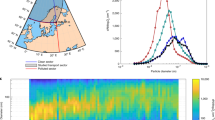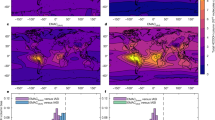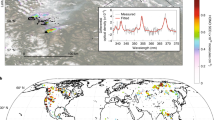Abstract
Formic acid contributes significantly to acid rain in remote environments1,2. Direct sources of formic acid include human activities, biomass burning and plant leaves. Aside from these direct sources, sunlight-induced oxidation of non-methane hydrocarbons (largely of biogenic origin) is probably the largest source3,4. However, model simulations substantially underpredict atmospheric formic acid levels5,6,7, indicating that not all sources have been included in the models. Here, we use satellite measurements of formic acid concentrations to constrain model simulations of the global formic acid budget. According to our simulations, 100–120 Tg of formic acid is produced annually, which is two to three times more than that estimated from known sources. We show that 90% of the formic acid produced is biogenic in origin, and largely sourced from tropical and boreal forests. We suggest that terpenoids—volatile organic compounds released by plants—are the predominant precursors. Model comparisons with independent observations of formic acid strengthen our conclusions, and provide indirect validation for the satellite measurements. Finally, we show that the larger formic acid emissions have a substantial impact on rainwater acidity, especially over boreal forests in the summer, where formic acid reduces pH by 0.25–0.5.
This is a preview of subscription content, access via your institution
Access options
Subscribe to this journal
Receive 12 print issues and online access
$259.00 per year
only $21.58 per issue
Buy this article
- Purchase on Springer Link
- Instant access to full article PDF
Prices may be subject to local taxes which are calculated during checkout



Similar content being viewed by others
References
Galloway, J. N., Likens, G. E., Keene, W. C. & Miller, J. M. The composition of precipitation in remote areas of the world. J. Geophys. Res. 87, 8771–8786 (1982).
Chameides, W. L. & Davis, D. D. Aqueous-phase source of formic acid in clouds. Nature 304, 427–429 (1983).
Kavouras, I. G., Mihalopoulos, N. & Stephanou, E. G. Formation of atmospheric particles from organic acids produced by forests. Nature 395, 683–686 (1998).
Glasius, M. Sources to formic acid studied by carbon isotopic analysis and air mass characterization. Atmos. Environ. 34, 2471–2479 (2000).
von Kuhlmann, R., Lawrence, M. G., Crutzen, P. J. & Rasch, P. J. A model for studies of tropospheric ozone and nonmethane hydrocarbons: Model evaluation of ozone-related species. J. Geophys. Res. 108, 4729 (2003).
Ito, A., Sillman, S. & Penner, J. E. Effects of additional nonmethane volatile organic compounds, organic nitrates, and direct emissions of oxygenated organic species on global tropospheric chemistry. J. Geophys. Res. 112, D06309 (2007).
Paulot, F. et al. Importance of secondary sources in the atmospheric budgets of formic and acetic acids. Atmos. Chem. Phys. 11, 1989–2013 (2011).
Kawamura, K., Ng, L. L. & Kaplan, I. R. Determination of organic acids (C1–C10) in the atmosphere, motor exhausts and engine oils. Environ. Sci. Technol. 19, 1082–1086 (1985).
Andreae, M. O. & Merlet, P. Emission of trace gases and aerosols from biomass burning. Glob. Biogeochem. Cycles 15, 955–966 (2001).
Gabriel, R., Schäfer, L., Gerlach, C., Rausch, T. & Kesselmeier, J. Factors controlling the emissions of volatile organic acids from leaves of Quercus ilex L. (Holm oak). Atmos. Environ. 33, 1347–1355 (1999).
Sanhueza, E. & Andreae, M. O. Emissions of formic and acetic acids from tropical savanna soils. Geophys. Res. Lett. 18, 1707–1710 (1991).
Graedel, T. E. & Eisner, T. Atmospheric formic acid from formicine ants: a preliminary assessment. Tellus B 40, 335–339 (1988).
Ohta, K., Ogawa, H. & Mizuno, T. Abiological formation of formic acid on rocks in nature. Appl. Geochem. 15, 91–95 (2000).
Neeb, P., Sauer, F., Horie, O. & Moortgat, G. R. Formation of hydroxymethyl hydroperoxide and formic acid in alkene ozonolysis in the presence of water vapor. Atmos. Environ. 31, 1417–1423 (1997).
Müller, J-F. & Stavrakou, T. Inversion of CO and NOx emissions using the adjoint of the IMAGES model. Atmos. Chem. Phys. 5, 1157–1186 (2005).
Stavrakou, T. et al. Evaluating the performance of pyrogenic and biogenic emission inventories against one decade of space-based formaldehyde columns. Atmos. Chem. Phys. 9, 1037–1060 (2009).
Paulot, F. et al. Unexpected epoxide formation in the gas-phase photooxidation of isoprene. Science 325, 730–733 (2009).
Peeters, J. & Müller, J-F. HOx radical regeneration in isoprene oxidation via peroxy radical isomerisations, II: Experimental evidence and global impact. Phys. Chem. Chem. Phys. 12, 14227–14235 (2010).
González Abad, G. et al. Global distribution of upper tropospheric formic acid from the ACE-FTS. Atmos. Chem. Phys. 9, 8039–8047 (2009).
Grutter, M. et al. Global distribution and variability of formic acid as observed by MIPAS-ENVISAT. J. Geophys. Res. 115, D10303 (2010).
Clerbaux, C. et al. Monitoring of atmospheric composition using the thermal infrared IASI/MetOp sounder. Atmos. Chem. Phys. 9, 6041–6054 (2009).
Clarisse, L., Clerbaux, C., Dentener, F., Hurtmans, D. & Coheur, P. F. Global ammonia distribution derived from infrared satellite observations. Nature Geosci. 2, 479–483 (2009).
Razavi, A. et al. Global distributions of methanol and formic acid retrieved for the first time from the IASI/MetOp thermal infrared sounder. Atmos. Chem. Phys. 11, 857–872 (2011).
Stavrakou, T. et al. First space-based derivation of the global atmospheric methanol emission fluxes. Atmos. Chem. Phys. 11, 4873–4898 (2011).
Kuhn, U. et al. Exchange of short-chain monocarboxylic acids by vegetation at a remote tropical forest site in Amazonia. J. Geophys. Res. 107, 8069 (2002).
Kesselmeier, J., Bode, K., Gerlach, C. & Jork, E. M. Exchange of atmospheric formic and acetic acids with trees and crop plants under controlled chamber and purified air conditions. Atmos. Environ. 32, 1765–1775 (1998).
Holzinger, R., Lee, A., McKay, M. & Goldstein, A. H. Seasonal variability of monoterpene emission factors for a Ponderosa pine plantation in California. Atmos. Chem. Phys. 6, 1267–1274 (2006).
Di Carlo, P. et al. Missing OH reactivity in a forest: Evidence for unknown reactive biogenic VOCs. Science 304, 722–725 (2004).
Andreae, M. O., Talbot, R. W., Andreae, T. W. & Harriss, R. C. Formic and acetic acid over the Central Amazon Region, Brazil 1. Dry season. J. Geophys. Res. 93, 1616–1624 (1988).
Keene, W. C. & Galloway, J. N. Organic acidity in precipitation of North America. Atmos. Environ. 18, 2491–2497 (1984).
Acknowledgements
This study has been supported by the projects PRODEX A3C of the European Space Agency funded by the Belgian Science Policy Office, and the IBOOT, BIOSOA, AGACC and AGACC-II projects within the ‘Science for a Sustainable Development’ research programme funded by the Belgian Science Policy Office. Financial support by the ‘Actions de Recherche Concertées’ (Communauté Française de Belgique) is also acknowledged. IASI has been developed and built under the responsibility of the Centre National d’Etudes Spatiales (CNES, France). It is flown onboard the Metop satellites as part of the EUMETSAT Polar System. The IASI L1 data are received through the EUMETCast near-real-time data distribution service. L.C. and P-F.C. are respectively Postdoctoral Researcher and Research Associate with F.R.S.-FNRS. The Australian Research Council (Grant DP110101948) is gratefully acknowledged for their funding of the Wollongong HCOOH measurements. C.V. and M.D.M. are grateful to the BIRA and LACY team members who support the FTIR observations at Reunion Island.
Author information
Authors and Affiliations
Contributions
T.S. and J-F.M. obtained the results, drafted the manuscript and prepared the figures. J.P. developed the isoprene degradation mechanism used to estimate the photochemical source of formic acid in the model. A.R., L.C., P-F.C., D.H. and C.C. carried out the first retrievals of formic acid observations from space. C.C. also contributed actively in the development of the IASI sensor. C.V. and M.D.M. retrieved the FTIR data at Reunion Island. N.M.D., D.W.T.G., N.J. and C.P-W. retrieved the FTIR observations at Wollongong.
Corresponding author
Ethics declarations
Competing interests
The authors declare no competing financial interests.
Supplementary information
Supplementary Information
Supplementary Information (PDF 9057 kb)
Rights and permissions
About this article
Cite this article
Stavrakou, T., Müller, JF., Peeters, J. et al. Satellite evidence for a large source of formic acid from boreal and tropical forests. Nature Geosci 5, 26–30 (2012). https://doi.org/10.1038/ngeo1354
Received:
Accepted:
Published:
Issue Date:
DOI: https://doi.org/10.1038/ngeo1354
This article is cited by
-
Direct gas-phase formation of formic acid through reaction of Criegee intermediates with formaldehyde
Communications Chemistry (2023)
-
Underrated primary biogenic origin and lifetime of atmospheric formic and acetic acid
Scientific Reports (2021)
-
Ubiquitous atmospheric production of organic acids mediated by cloud droplets
Nature (2021)
-
Photo-tautomerization of acetaldehyde as a photochemical source of formic acid in the troposphere
Nature Communications (2018)
-
Triazine-based graphitic carbon nitride: controllable synthesis and enhanced cataluminescent sensing for formic acid
Analytical and Bioanalytical Chemistry (2018)



